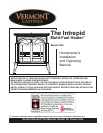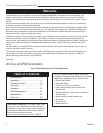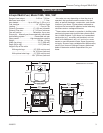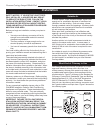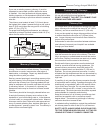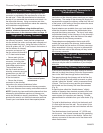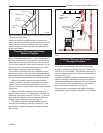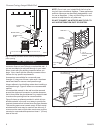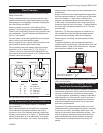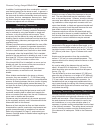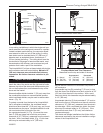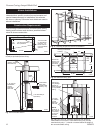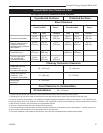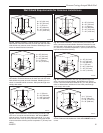
5
Vermont Castings Intrepid Multi-Fuel
2000970
If you use an existing masonry chimney, it must be
inspected to ensure safe condition before the stove
is installed. Your local professional chimney sweep,
building inspector, or fire department official will be able
to inspect the chimney or provide a referral to someone
who can.
The chimney must extend at least 3’ (914 mm) above
the highest point where it passes through a roof, and at
least 2’ (610 mm) higher than any portion of a building
within 10’ (3 m). (Fig. 3)
For proper draft and good performance, any chimney
used with an Intrepid II should extend at least 16’ (5 m)
above the flue collar of the stove.
Masonry Chimneys
An inspection of the chimney must confirm that it has
a lining. Do not use an unlined chimney. The chimney
should have no cracks, loose mortar, other signs of
deterioration, or blockage. Repair any defects before
using the chimney with your stove.
Seal any unused openings in an existing masonry chim-
ney with masonry to the thickness of the chimney wall,
and repair the chimney liner. Openings sealed with pie
plates or wallpaper are a hazard; seal them with mortar
or refractory cement. In the event of a chimney fire,
flames and smoke may be forced out of these unused
thimbles.
The chimney should be thoroughly cleaned before use.
A newly-built masonry chimney must conform to the
standards of your local building code or, in the absence
of a local code, to a recognized national code. Masonry
chimneys must be lined, either with code-approved ma-
sonry or precast refractory tiles, stainless steel pipe, or
a code-approved, “poured-in-place” liner. The chimney’s
clean-out door must seal tightly.
Prefabricated Chimneys
A prefabricated metal chimney must be one recognized
for use with solid-fuel burning appliances.
DO NOT CONNECT THIS UNIT TO A CHIMNEY FLUE
SERVING ANOTHER APPLIANCE.
Chimney Size
An Intrepid Multi-fuel is approved for venting into a ma-
sonry chimney with a nominal flue size of 8” x 8” (200 x
200 mm), and into a round flue size of 6” (150 mm).
It may not be vented into larger chimneys without a liner
to reduce the effective flue size to 6”(150mm) diam-
eter. Larger chimneys must have their flues relined for
proper stove performance.
Accessories to make the connection between stainless
steel chimney liners and your Intrepid II are available
through your local dealer.
Chimney Connector Guidelines
Chimney connector is the double-wall or single-wall
pipe that connects the stove to the chimney. The chim-
ney is a masonry or prefabricated structure that enclos-
es the flue. Chimney connectors are used only to make
the connection from the stove to the chimney.
Double-wall chimney connectors must be tested and
listed for use with solid-fuel burning appliances. Sin-
gle-wall chimney connectors should be made of 24
gauge or heavier steel, and should be 6” (150 mm) in
diameter. Do not use galvanized connector; it cannot
withstand the high temperatures that can be reached by
smoke and gases, and may release toxic fumes under
high heat.
If possible, do not pass the chimney connector through
a combustible wall or ceiling. If passage through a com-
bustible wall is unavoidable, refer to the section follow-
ing on Wall Pass-Throughs. Do not pass the chimney
connector through an attic, a closet, or any similar con-
cealed space. The whole connector should be exposed
and accessible for inspection and cleaning.
Keep the horizontal run of chimney connector as short
and direct as possible, with no more than one 45
degree elbow. The maximum total length of chimney
connector should not exceed 8 feet.
In cathedral ceiling installations, extend the prefabricat-
ed chimney down to within 8 feet (2.5 m) of the stove.
SAFETY NOTE: ALWAYS WEAR GLOVES AND PRO-
TECTIVE EYEWEAR WHEN DRILLING, CUTTING OR
JOINING SECTIONS OF CHIMNEY CONNECTOR.
2' Min.
2' Min.
3'
Min.
0 To 10'
3'
Min.
0 To 10'
AC617
RLTSKC8
2/11/98
AC617
Fig. 3 The 2’-3’-10’ Chimney Rule.
Reference Point



